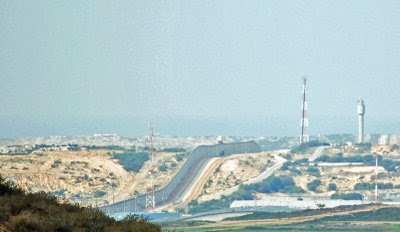 Iranian President Ahmadinejad at Natanz enrichment facility
Iranian President Ahmadinejad at Natanz enrichment facilityDuring my recent visit to Israel, Iran was one of the major topics of discussion. I spoke with political, military and intelligence officials about the threat posed by Iran's nuclear weapons program. The prevailing attitude about this threat was markedly different than my previous visit to Israel in late 2006.
At that time, in the aftermath of the war in Lebanon, Iran was the main item of discussion on virtually everyone's agenda and was described in almost biblical terms as "the existential" threat to the state of Israel. While Israelis are rightfully concerned about Iran's potential acquisition of a nuclear weapon, they appear to have gathered more information on the Iranian program and put it into a slightly different perspective. Now they view Iran's program as "an" existential threat - there are more than one, including the Palestinian issue. While Iran is still the major threat to Israel, it was not the all-consuming issue it was in 2006.
Israeli intelligence (Mossad) analysts believe that Iran will have amassed enough low-enriched uranium (LEU) that can be processed into sufficient highly-enriched uranium (HEU) for one nuclear weapon by the end of 2009. To begin processing the LEU into HEU required for a weapon, Iran will have to withdraw from the Non-Proliferation Treaty (NPT). Withdrawing from the NPT will erase any doubts about the true intentions of Iran's nuclear program.
What are Israel's current options? Can something be done before Iran withdraws from the NPT? Is the military option the only option that will prevent Iran from acquiring a nuclear weapon?
A coherent Israeli position is emerging. Almost all Israelis believe that the Iranians are the primary threat to the country and that deterrence is the preferred option. Failing deterrence, military action will be necessary. Successful military action against the Iranian program will be difficult, but the Israelis may believe they have no other option.
According to Likud Knesset member Yuval Shteinitz, Iran will have a nuclear weapon within two years. He favors telling the Iranians that if they do not cease their program by a certain date, military action is unavoidable. He believes this will be effective because the Iranians halted their program temporarily after the American invasion of Iraq - specifically the fall of Baghdad - since they thought they might be next. Former National Security Council Chairman Major General (Reserve) Uzi Dayan (with author in photo) favors sanctions on Iran as the initial means of pressuring Iran to stop their uranium enrichment program. In addition to a boycott on Iranian oil and prevention of imports of refined gasoline and diesel, Dayan proposes a maritime inspection protocol of vessels bound for Iranian ports.
Former National Security Council Chairman Major General (Reserve) Uzi Dayan (with author in photo) favors sanctions on Iran as the initial means of pressuring Iran to stop their uranium enrichment program. In addition to a boycott on Iranian oil and prevention of imports of refined gasoline and diesel, Dayan proposes a maritime inspection protocol of vessels bound for Iranian ports.
While that would likely be effective, the international community is too sensitive to Persian Gulf oil flows that support for such measures would be hard to gather. Quarantining ports is tantamount to an act of war. Since there is little international support for the level of sanctions required to ameliorate Iranian behavior, Dayan believes Israel must be prepared to execute a unilateral military strike on Iranian nuclear facilities. Likud leader Benjamin "Bibi" Netanyahu (with author in photo), currently the front runner to win the prime minister position in the February 10 elections, believes that Iran's acquisition of nuclear weapons is a greater threat to the world than the current economic crisis. He too favors a military option if the international community is unable or unwilling to solve the Iranian nuclear issue.
Likud leader Benjamin "Bibi" Netanyahu (with author in photo), currently the front runner to win the prime minister position in the February 10 elections, believes that Iran's acquisition of nuclear weapons is a greater threat to the world than the current economic crisis. He too favors a military option if the international community is unable or unwilling to solve the Iranian nuclear issue.
Assuming Israel has decided on the military option, their prospects are not good. How will the aircraft fly from their bases in Israel to a target located 200 miles inside Iran?

There are three possible ways to get there – either through Turkey (green), Saudi Arabia (red) or Iraq (blue), possibly a combination of all three, or even the use of Jordanian airspace as well.
In any case, the route is a one-way trip of at least 1200 miles. Even though Turkey and Israel have had a defense agreement since 1996, Israel's recent actions in Gaza have soured their relationship with Turkey and may have jeopardized this option. Use of Turkish airspace lengthens the route, but keeps the aircraft in relatively friendly airspace the longest (assuming American-controlled Iraqi airspace is friendly), but requires American support with Iraqi airspace issues for Israeli refueling tankers, or the use of U.S. Air Force tankers.
Any of these options presents a high risk of failure. See my earlier analyses of these military options:
- Iran - Israel's Air Strike Options (March 2006)
- Iran - Israel's Air Strike Options Update (June 2008)
The question is, will Israel sit by as Iran develops a nuclear weapon? My guess is no.





















.jpg)
